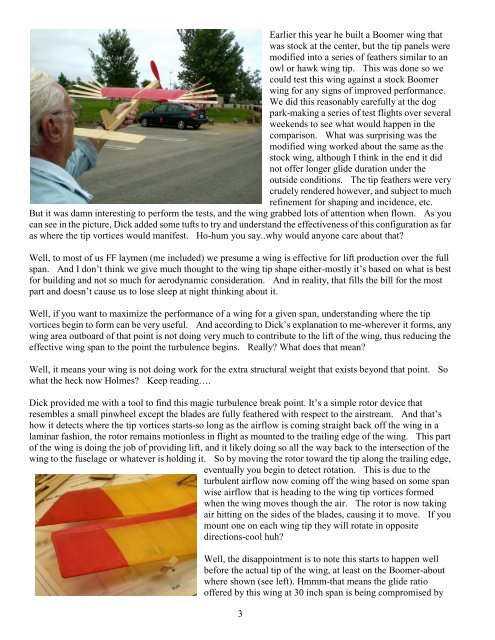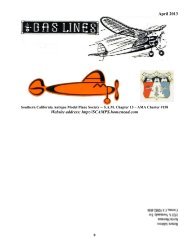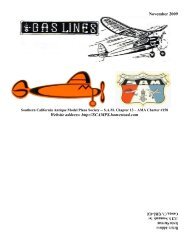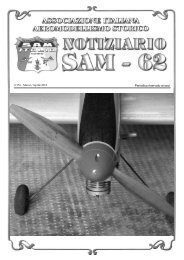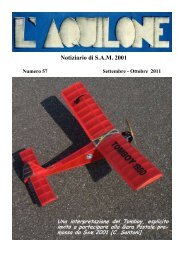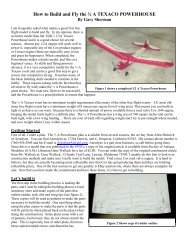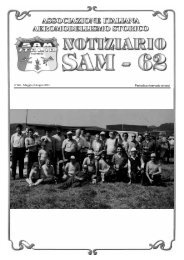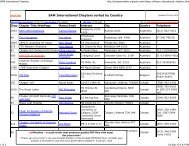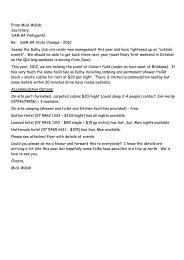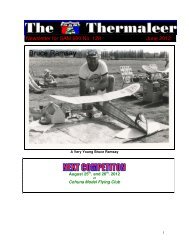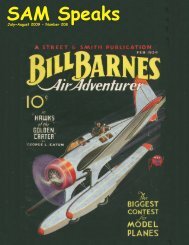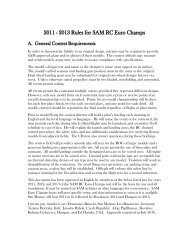Southern California Antique Model Plane Society – Sam 13
Southern California Antique Model Plane Society – Sam 13
Southern California Antique Model Plane Society – Sam 13
Create successful ePaper yourself
Turn your PDF publications into a flip-book with our unique Google optimized e-Paper software.
Earlier this year he built a Boomer wing that<br />
was stock at the center, but the tip panels were<br />
modified into a series of feathers similar to an<br />
owl or hawk wing tip. This was done so we<br />
could test this wing against a stock Boomer<br />
wing for any signs of improved performance.<br />
We did this reasonably carefully at the dog<br />
park-making a series of test flights over several<br />
weekends to see what would happen in the<br />
comparison. What was surprising was the<br />
modified wing worked about the same as the<br />
stock wing, although I think in the end it did<br />
not offer longer glide duration under the<br />
outside conditions. The tip feathers were very<br />
crudely rendered however, and subject to much<br />
refinement for shaping and incidence, etc.<br />
But it was damn interesting to perform the tests, and the wing grabbed lots of attention when flown. As you<br />
can see in the picture, Dick added some tufts to try and understand the effectiveness of this configuration as far<br />
as where the tip vortices would manifest. Ho-hum you say..why would anyone care about that?<br />
Well, to most of us FF laymen (me included) we presume a wing is effective for lift production over the full<br />
span. And I don’t think we give much thought to the wing tip shape either-mostly it’s based on what is best<br />
for building and not so much for aerodynamic consideration. And in reality, that fills the bill for the most<br />
part and doesn’t cause us to lose sleep at night thinking about it.<br />
Well, if you want to maximize the performance of a wing for a given span, understanding where the tip<br />
vortices begin to form can be very useful. And according to Dick’s explanation to me-wherever it forms, any<br />
wing area outboard of that point is not doing very much to contribute to the lift of the wing, thus reducing the<br />
effective wing span to the point the turbulence begins. Really? What does that mean?<br />
Well, it means your wing is not doing work for the extra structural weight that exists beyond that point. So<br />
what the heck now Holmes? Keep reading….<br />
Dick provided me with a tool to find this magic turbulence break point. It’s a simple rotor device that<br />
resembles a small pinwheel except the blades are fully feathered with respect to the airstream. And that’s<br />
how it detects where the tip vortices starts-so long as the airflow is coming straight back off the wing in a<br />
laminar fashion, the rotor remains motionless in flight as mounted to the trailing edge of the wing. This part<br />
of the wing is doing the job of providing lift, and it likely doing so all the way back to the intersection of the<br />
wing to the fuselage or whatever is holding it. So by moving the rotor toward the tip along the trailing edge,<br />
eventually you begin to detect rotation. This is due to the<br />
turbulent airflow now coming off the wing based on some span<br />
wise airflow that is heading to the wing tip vortices formed<br />
when the wing moves though the air. The rotor is now taking<br />
air hitting on the sides of the blades, causing it to move. If you<br />
mount one on each wing tip they will rotate in opposite<br />
directions-cool huh?<br />
Well, the disappointment is to note this starts to happen well<br />
before the actual tip of the wing, at least on the Boomer-about<br />
where shown (see left). Hmmm-that means the glide ratio<br />
offered by this wing at 30 inch span is being compromised by<br />
3


